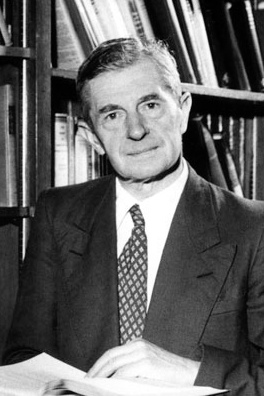Sydney Chapman (mathematician) facts for kids
Quick facts for kids
Sydney Chapman
|
|
|---|---|

Sydney Chapman 1888–1970
|
|
| Born | 29 January 1888 Eccles, Greater Manchester, England
|
| Died | 16 June 1970 (aged 82) Boulder, Colorado, U.S.
|
| Alma mater | University of Manchester University of Cambridge |
| Known for | Chapman cycle Chapman function Chapman–Kolmogorov equation Chapman–Enskog theory |
| Awards | Fellow of the Royal Society (1919) Smith's Prize (1913) Adams Prize (1928) Royal Medal (1934) Chree Medal and Prize (1941) De Morgan Medal (1944) William Bowie Medal (1962) Copley Medal (1964) Symons Gold Medal (1965) |
| Scientific career | |
| Institutions | University of Manchester University of Cambridge Imperial College London University of Oxford The Queen's College, Oxford Royal Observatory, Greenwich, University of Colorado |
| Academic advisors | G. H. Hardy |
| Doctoral students |
|
Sydney Chapman (born January 29, 1888, died June 16, 1970) was a brilliant British scientist. He was a mathematician and a geophysicist. A geophysicist studies the Earth using physics. Chapman's work helped us understand many things. He studied how gases move, how the Sun affects Earth, and the Earth's ozone layer. His ideas have helped scientists for a long time.
Contents
Early Life and School
Sydney Chapman was born in Eccles, England. This town is near Salford. He started his advanced studies at a technical school in 1902. This school is now called the University of Salford.
In 1904, when he was 16, Chapman went to the University of Manchester. He won a scholarship to attend. He was the very last student chosen for the scholarship. Chapman later wondered what would have happened if he hadn't been picked.
He first studied engineering at the university. But he loved mathematics so much that he stayed an extra year. He earned a degree in mathematics. Following his professor's advice, Chapman applied for a scholarship to Trinity College, Cambridge. He received a full scholarship from his second year. He graduated from Cambridge in 1910.
Career and Discoveries
From 1914 to 1919, Chapman taught mathematics at Cambridge. He also worked as a fellow at Trinity College. He then became a professor at the University of Manchester. This was from 1919 to 1924. After that, he moved to Imperial College London. During the Second World War, he helped the Army Council with scientific advice.
In 1946, Chapman became a professor at Oxford University. He also became a fellow at The Queen's College, Oxford. After retiring from Oxford in 1953, Chapman traveled the world. He taught and did research in many places. These included the University of Alaska and the University of Colorado. He also visited cities like Istanbul, Cairo, and Tokyo.
Chapman spent three months each year in Alaska. He researched auroras there. Auroras are beautiful lights in the sky. He also spent time at the High Altitude Observatory in Colorado.
Important Research Areas
Chapman made big contributions to the study of stochastic processes. These are like random events that happen over time. He and a Russian scientist, Andrey Kolmogorov, developed important equations. These are called the Chapman–Kolmogorov equations.
In 1930, Chapman explained how the ozone layer is formed. The ozone layer is a part of Earth's atmosphere. It protects us from harmful sunlight.
Chapman was a leader in solar-terrestrial physics. This field studies how the Sun affects Earth. He looked at magnetic storms and auroras. He explained how they are linked to the Earth's magnetic field and the solar wind. The solar wind is a stream of particles from the Sun.
Chapman and his student, V. C. A. Ferraro, predicted the magnetosphere. This is a protective bubble around Earth. It helps shield us from the solar wind. Satellites later confirmed their predictions.
In 1940, Chapman and Julius Bartels wrote a key book on geomagnetism. Geomagnetism is the study of Earth's magnetic field. In 1946, Chapman created the word "Aeronomy". This is the study of the upper atmosphere and how it interacts with space.
Chapman was also president of the International Union of Geodesy and Geophysics (IUGG). This is a big group of scientists.
International Geophysical Year
Chapman was a leader for the International Geophysical Year (IGY). This was a special time for science. It happened in 1957–58. The idea for the IGY came from Chapman and other scientists.
The IGY led to huge progress in Earth and space sciences. It also led to the first satellite launches.
Awards and Recognition
Sydney Chapman received many honors during his career. He became a Fellow of the Royal Society in 1919. This is a very high honor for scientists in the UK. He also won the Royal Medal in 1934. In 1964, he received the Copley Medal. This is the highest award given by the Royal Society.
He was also elected to science academies in the United States, Norway, Sweden, and Finland. He served as president of the London Mathematical Society and the Royal Meteorological Society.
A crater on the Moon is named after him. The Sydney Chapman Building at the University of Alaska Fairbanks is also named in his honor. This building was the first home of the Geophysical Institute there. The American Geophysical Union holds "Chapman Conferences" to encourage new research. The Royal Astronomical Society created the Chapman Medal in his memory.
Personal Life
Sydney Chapman passed away in Boulder, Colorado, in 1970. He was 82 years old.
See also
 In Spanish: Sydney Chapman para niños
In Spanish: Sydney Chapman para niños

